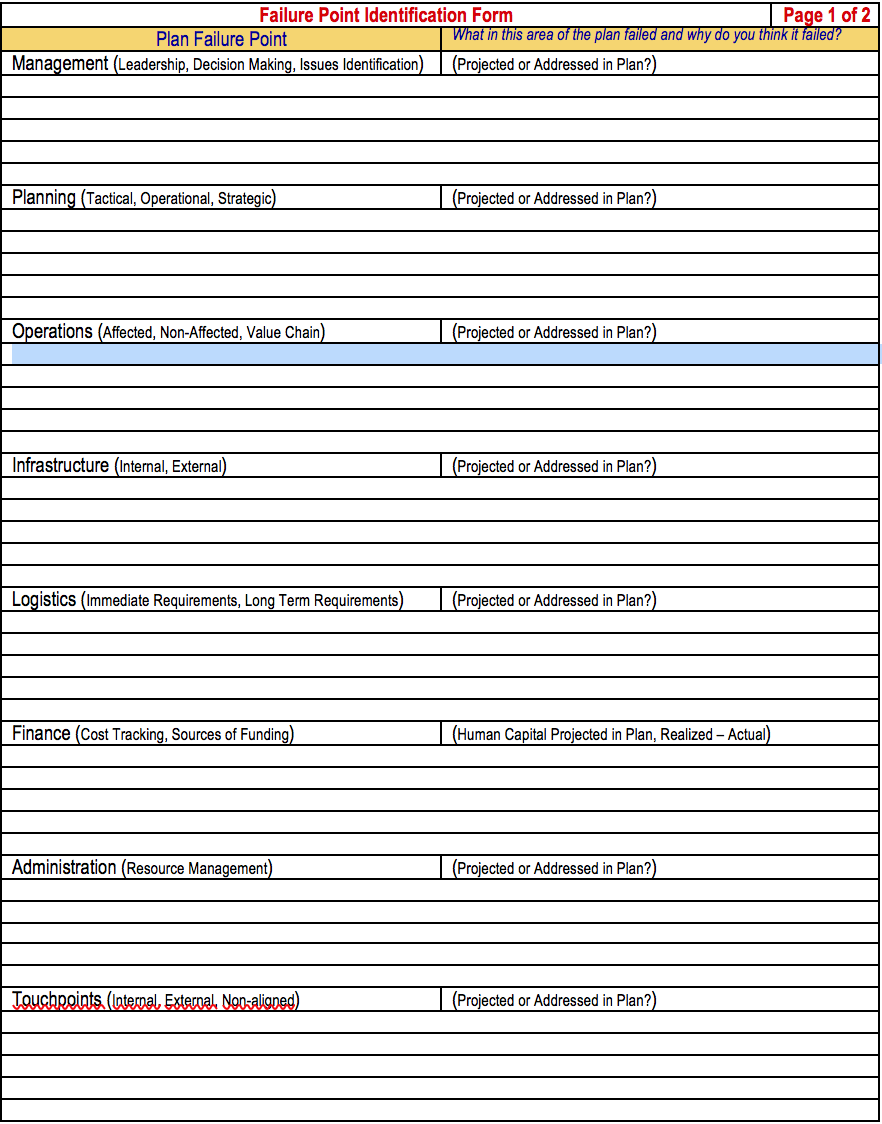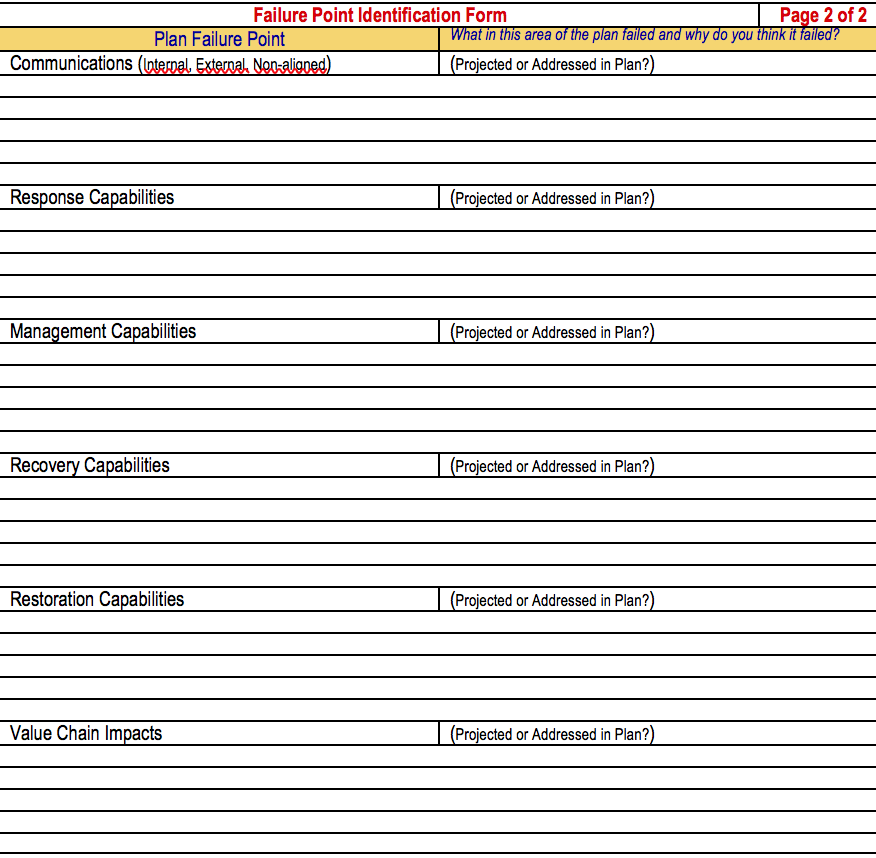 Imagine that your plan has been implemented as it was designed. You and your organization carried out the plan following every detail that was contained in the planning documents. Your plan has failed. That is all you know. Your plan failed. Now your challenge and that of your planning team is to explain why they think that the plan failed. You must determine how much contrary evidence (information) was explained away based on the theory that the plan you developed will succeed if you implement the steps required to respond to a disruption of your business operations.
Imagine that your plan has been implemented as it was designed. You and your organization carried out the plan following every detail that was contained in the planning documents. Your plan has failed. That is all you know. Your plan failed. Now your challenge and that of your planning team is to explain why they think that the plan failed. You must determine how much contrary evidence (information) was explained away based on the theory that the plan you developed will succeed if you implement the steps required to respond to a disruption of your business operations.
The goal of this type of exercise is to break the emotional attachment to the plan’s success. When we create a plan we become emotionally attached to its success. By showing the likely sources of breakdown that will impede and/or negate the plan (failure), we utilize a methodology that allows us to conduct a validation of the plan by determining the potential failure points that are not readily apparent in typical exercise processes.
Decision scenarios allow us to describe forces that are operating to enable the use of judgment. Based on the Failure Point Methodology, we can identify, define and assess the dependencies and assumptions that were made in developing the plan. This methodology facilitates a non-biased and critical analysis of the plan that allows planners and the Business Continuity Team (personnel assigned to carry out the plan) to better understand the limitations that they may face when implementing the plan in a response to an actual event.
The Scenario, Worksheets, Discussion Guides
Developing the exercise scenario for the Failure Point Methodology is predicated on coherence, completeness, plausibility and consistency. It is recognized at the beginning of the scenario that the plan has failed. It is therefore not really necessary to create an elaborate scenario describing catastrophic events in great detail. The participants can identify trigger points that could create a reason for the plan to fail. This allows for maximizing the creativity of the Business Continuity Team in listing why the plan has failed and how to overcome the failure points that have been identified. This also is a good secondary method for ensuring that the Business Continuity Team is trained on the plan and that they have read and digested the information contained in the plan. As it is often the case that the plan developers are not the primary and/or secondary implementers of the plan; and that the implementers of the plan often have limited input during the creation of the plan (time limited interviews, response to questionnaires, etc.) this type of exercise immerses the participants in creative thought generation as to why the plan failed. It also provides emphasis for ownership and greater participation in developing the plan.
In order to facilitate discussion of how the plan could have failed a discussion matrix (figure 1) can be used. The discussion matrix should be designed to trigger a dialogue and allow for a free ranging discussion of ways that the plan could have failed (“how did we get to this point?”). Generally, I have found the following topic points to be excellent generators of identification and subsequent discussion regarding failure points; these are:
Results: the Scenario, Worksheets and Discussion Guides
One result we find is that there is a consensus about the traditional rational planning methodology used to create a typical Business Continuity Plan (BIA – Plan Development – Maintenance). Admittedly the traditional planning process provides a relatively good, albeit it narrow, basis for the Business Continuity Plan. And, there is value in attempting to envision goals more clearly in the preparation and planning process. Nevertheless, participants overwhelmingly agree that there are limitations to this traditional process, in that one cannot make plans for complex emergent situations (such as an unpredictable disruptive event). By developing plans that provide sufficient flexibility, we can prepare to improvise as we redefine goals midway through a disruptive event.
A second result is that creativity, while appreciated and encouraged, needs to be managed carefully. Over the years a range of creative methods have been in the spotlight – brainstorming, permutations of planning elements, etc.
A third outcome is that participants recognize that plans can differ with regard to their focus, the functions that they serve and the depth of detail that they provide. We learned that planning is not a simple, unified activity that can be relegated to computer driven planning programs (the result of which is to produce an inventory list instead of a plan that provides guidance and flexibility for decision makers). Generally, participants who have participated in Failure Point Exercises have categorized exercise outputs relating to planning functions and the function of plans to include the following:
- Directing and coordinating the actions of Business Continuity Team members
- Basis for shared situation awareness
- Generating expectancies
- Supporting improvisation
- Detecting inconsistencies
- Establishing time horizons
- Shaping the thinking of planners
- Identifying a common terminology and classification methodology
We have found that plans differ along some key dimensions:
- How precisely the plan was made
- Whether the plan was modular (relatively independent components that could be implemented as necessary)
- The level of integration of the plan with co-existing plans (security plan, evacuation plan, etc.)
- How well coordination of all elements can be accomplished
- Level of complexity of the plan contents
- Degree of precision (i.e., how many steps you are locked into performing)
Conclusion
Participants generally agree that the benefit of the Failure Point Exercise Methodology is to recast the planning process as a type of problem solving that requires the identification of the nonlinear aspects of problem identification and solution development (Critical Thinking) versus the traditional problem solving performed during drills and exercises that are designed to validate the success of the plan and often explain away any discrepancies that arise. The Failure Point Methodology creates a learning environment that allows planners and plan implementers to break their emotional attachments to the plan’s success and recognize that plans do not necessarily reflect reality, but are our best effort to anticipate disruptive events.
Bio:
Geary Sikich is a Principal with Logical Management Systems, Corp., a consulting and executive education firm with a focus on enterprise risk management and issues analysis; the firm’s web site is www.logicalmanagement.com. Geary is also engaged in the development and financing of private placement offerings in the alternative energy sector (biofuels, etc.), multi-media entertainment and advertising technology and food products. Geary developed LMSCARVERtm the “Active Analysis” framework, which directly links key value drivers to operating processes and activities. LMSCARVERtm provides a framework that enables a progressive approach to business planning, scenario planning, performance assessment and goal setting.
Prior to founding Logical Management Systems, Corp. in 1985 Geary held a number of senior operational management positions in a variety of industry sectors. Geary served as an intelligence officer in the U.S. Army; responsible for the initial concept design and testing of the U.S. Army’s National Training Center and other intelligence related activities. Geary holds a M.Ed. in Counseling and Guidance from the University of Texas at El Paso and a B.S. in Criminology from Indiana State University.
Geary is also an Adjunct Professor at Norwich University, where he teaches Enterprise Risk Management (ERM) and contingency planning electives in the MSBC program, including “Value Chain” Continuity, Pandemic Planning and Strategic Risk Management. He is presently active in Executive Education, where he has developed and delivered courses in enterprise risk management, contingency planning, performance management and analytics. Geary is a frequent speaker on business continuity issues business performance management. He is the author of over 200 published articles and four books, his latest being “Protecting Your Business in Pandemic,” published in June 2008 (available on Amazon.com).
Geary is a frequent speaker on high profile continuity issues, having developed and validated over 2,000 plans and conducted over 250 seminars and workshops worldwide for over 100 clients in energy, chemical, transportation, government, healthcare, technology, manufacturing, heavy industry, utilities, legal & insurance, banking & finance, security services, institutions and management advisory specialty firms. Geary consults on a regular basis with companies worldwide on business-continuity and crisis management issues.


